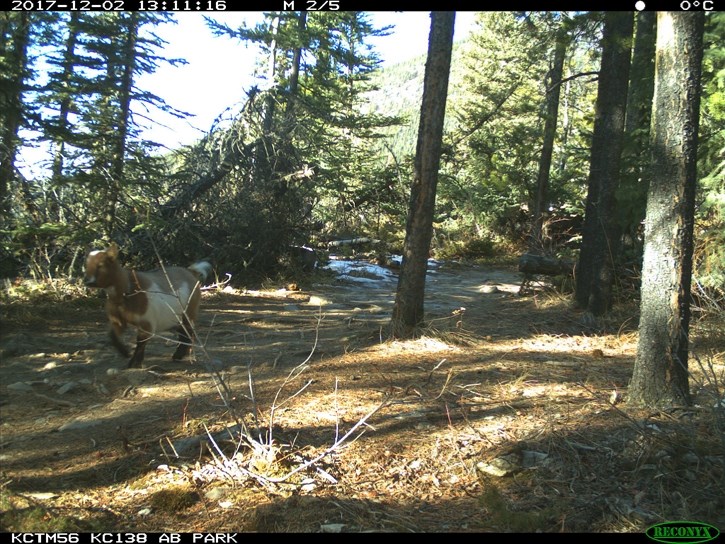KANANASKIS – A pet goat on a trail in Kananaskis Country has raised a red flag for wildlife experts who are concerned about the potential for disease to spread from domestic goats to wild bighorn sheep.
An Alberta Parks wildlife camera captured a photo of an off-leash pet goat on Prairie Mountain in K-Country last December. It was the first known instance of a domestic goat in the protected area.
John Paczkowski, an ecologist with the Parks division of Alberta Environment and Parks (AEP), said in addition to the goat, cameras have also recorded people walking their pigs, and cats (on leash) in the Kananaskis backcountry.
“Although it may seem like a lighthearted occurrence, the potential for disease transmission is real and the effects would be insidious,” said Paczkowski.
“We might not find out about disease transmission until it is too late.”
The province’s wildlife disease specialist with Alberta Fish and Wildlife said the biggest concern is domestic goats and sheep can pass on disease to bighorn sheep, which are highly susceptible to respiratory diseases and pneumonia.
Margot Pybus said there have been several recorded instances where bighorn sheep populations have been killed off, noting a single domestic goat that wandered onto bighorn range in the U.S. was enough to initiate a die off of wild sheep.
“There have been multiple die offs of bighorn sheep that relate to pneumonia, and many times those are linked to some presence or overlap of their range with domestic sheep; but there’s been a few situations that involve domestic goats too,” she said.
“That kind of activity of having a pet goat in Kananaskis would be a high risk activity, with the risk being the potential to kick off one of the bighorn die offs.”
Alberta Environment and Parks estimates there are about 6,900 bighorn sheep on Alberta lands, with an additional 4,500 on national park lands, making it the largest population of bighorn sheep in North America.
Bighorn sheep are the provincial mammal.
Unlike in many wildlife situations, the pathogen most closely associated with pneumonia in bighorns is not native to North America; therefore, bighorns have not had evolutionary time to adapt to it.
Since 1978, four bighorn sheep die offs were documented in Alberta involing pneumonia – the southwest Alberta Yarrow-Castle herd once and the Sheep River population three times.
Consistent with outbreaks in other areas, population recovery is slow in conjunction with high mortality of lambs in succeeding years. It takes at least five years following a die off before lamb survival can support a significant increase in a herd.
During the early 1980s, pneumonia infected the Yarrow-Castle bighorn sheep population in southwestern Alberta, resulting in a dramatic decline in the population of 400 sheep to 140 individuals over a two-year period.
The population recovered to approximately 200 individuals by 1995. A general decline in the number of bighorn ewes through the mid-1990s observed through aerial surveys has slowly begun to stabilize more recently.
“That’s an example of how susceptible bighorns are,” said Pybus, noting that even low rates of pneumonia-related mortality in adults can thwart growth in bighorn populations.
“Once something gets going, it moves like wildfire and basically can wipe out bighorn populations.”
Meanwhile, Paczkowski said domestic livestock being brought by owners into protected parks could also act as an attractant to carnivores, which creates another potential set of problems.
“By law, domestic animals brought into Alberta Parks must be under control and on a leash and their droppings need to be picked up and disposed of properly,” said Paczkowski.
“We would strongly discourage people from bringing domestic livestock into the protected areas.”




